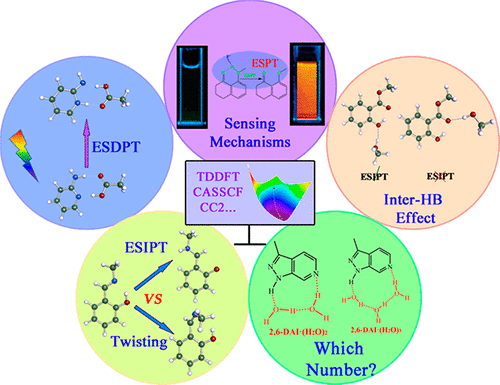当前位置:
X-MOL 学术
›
Acc. Chem. Res.
›
论文详情
Our official English website, www.x-mol.net, welcomes your feedback! (Note: you will need to create a separate account there.)
Unraveling the Detailed Mechanism of Excited-State Proton Transfer
Accounts of Chemical Research ( IF 18.3 ) Pub Date : 2018-06-15 00:00:00 , DOI: 10.1021/acs.accounts.8b00172 Panwang Zhou 1 , Keli Han 1
Accounts of Chemical Research ( IF 18.3 ) Pub Date : 2018-06-15 00:00:00 , DOI: 10.1021/acs.accounts.8b00172 Panwang Zhou 1 , Keli Han 1
Affiliation

|
As one of the most fundamental processes, excited-state proton transfer (ESPT) plays a major role in both chemical and biological systems. In the past several decades, experimental and theoretical studies on ESPT systems have attracted considerable attention because of their tremendous potential in fluorescent probes, biological imaging, white-light-emitting materials, and organic optoelectronic materials. ESPT is related to fluorescence properties and usually occurs on an ultrafast time scale at or below 100 fs. Consequently, steady-state and femtosecond time-resolved absorption, fluorescence, and vibrational spectra have been used to explore the mechanism of ESPT. However, based on previous experimental studies, direct information, such as transition state geometries, energy barrier, and potential energy surface (PES) of the ESPT reaction, is difficult to obtain. These data are important for unravelling the detailed mechanism of ESPT reaction and can be obtained from state-of-the-art ab initio excited-state calculations.
中文翻译:

阐明激发态质子转移的详细机制
作为最基本的过程之一,激发态质子转移(ESPT)在化学和生物系统中都起着重要作用。在过去的几十年中,由于ESPT系统在荧光探针,生物成像,发白光的材料以及有机光电材料方面的巨大潜力,因此对ESPT系统的实验和理论研究已引起了相当大的关注。ESPT与荧光特性有关,通常在100 fs或以下的超快时间范围内发生。因此,稳态和飞秒时间分辨的吸收,荧光和振动光谱已被用于探索ESPT的机理。但是,根据先前的实验研究,直接信息,例如ESPT反应的过渡态几何形状,能垒和势能面(PES),很难获得。这些数据对于阐明ESPT反应的详细机理很重要,可以从最新的从头算起激发态计算中获得。
更新日期:2018-06-15
中文翻译:

阐明激发态质子转移的详细机制
作为最基本的过程之一,激发态质子转移(ESPT)在化学和生物系统中都起着重要作用。在过去的几十年中,由于ESPT系统在荧光探针,生物成像,发白光的材料以及有机光电材料方面的巨大潜力,因此对ESPT系统的实验和理论研究已引起了相当大的关注。ESPT与荧光特性有关,通常在100 fs或以下的超快时间范围内发生。因此,稳态和飞秒时间分辨的吸收,荧光和振动光谱已被用于探索ESPT的机理。但是,根据先前的实验研究,直接信息,例如ESPT反应的过渡态几何形状,能垒和势能面(PES),很难获得。这些数据对于阐明ESPT反应的详细机理很重要,可以从最新的从头算起激发态计算中获得。



























 京公网安备 11010802027423号
京公网安备 11010802027423号